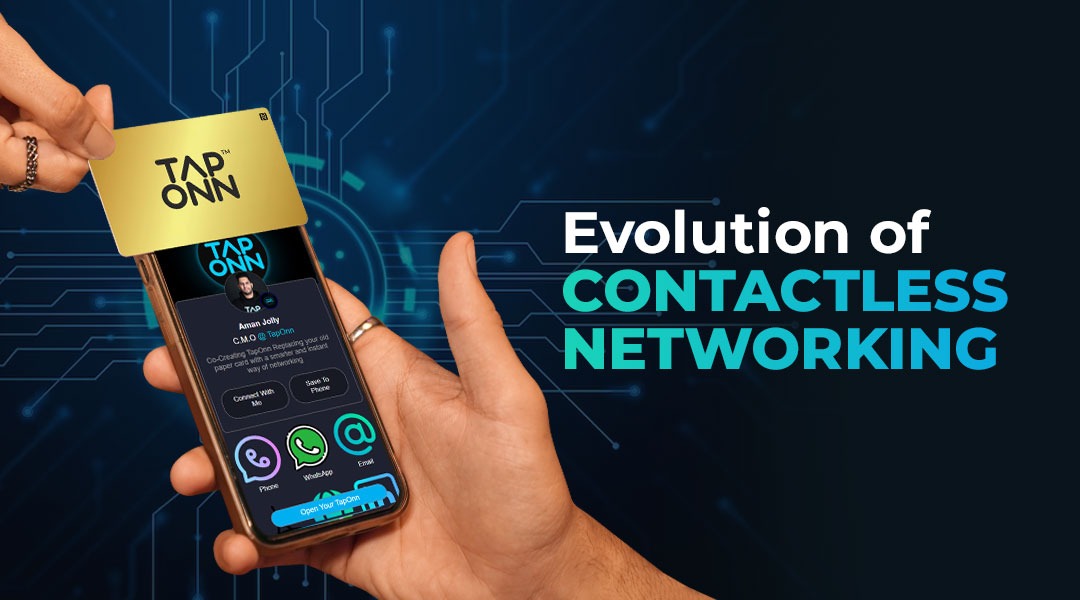
Evolution of Contactless Networking
What comes to your mind when you hear ‘NETWORKING’?
Perhaps your Instagram followers or your YouTube subscribers!
What comes to your grandparent’s mind when they hear about networking?
Maybe it will be conjured images of folks in business suits shaking hands at corporate events or a tangled web of wires connecting different computers.
Have you noticed any change in the concept of networking?
In a world that's constantly on the move, it's no surprise that our methods of staying connected have changed to keep up with the pace. Everyone wants to expand their network over time. From the days of dial-up internet to the lightning-fast broadband connections we enjoy today, the evolution of networking has been nothing short of revolutionary. But if there's one aspect of this digital journey that truly epitomizes the essence of modernity, it's the incredible transformation of contactless networking.
In this blog, we're going to embark on an exhilarating journey through the history, innovations, and awe-inspiring potential of contactless networking. But before jumping in, let us understand the term contactless networking.
What is contactless networking?
Contactless networking is nothing but a way for devices to talk to each other without physically touching or connecting with wires.
It's like magic communication through the air!
Think about when you use your phone or a card to pay at a store without swiping or inserting it into a machine. You just tap it, and the payment happens without any physical contact. That's contactless networking in action.
It is like a secret language that devices use to talk to each other without touching. From headphones to TV remote, almost every device today is using contactless networking. It makes our lives easier and more convenient, and you'll find it in many everyday situations.
Birth of contactless networking
The birth of contactless networking can be traced to the development of radio frequency identification (RFID) technology, which enabled the wireless exchange of data between RFID tags and readers.
In the mid-20th century, this technology found early applications in logistics and access control. For instance, RFID tags allowed for easy tracking of inventory in warehouses without physical contact. Over time, the concept of contactless communication evolved, leading to innovations like contactless smart cards that revolutionized access control and public transportation ticketing.
Ultimately, contactless networking's most widespread application emerged with contactless payments, enabling seamless transactions by tapping credit or debit cards near payment terminals, and later, by using smartphones with near-field communication (NFC) technology.
The advent of Bluetooth
Bluetooth technology was created in the late 1990s by a group of tech enthusiasts who wanted to make it easier for devices to communicate over short distances without wires.
Bluetooth works a bit like an invisible thread that connects your devices. When you turn on Bluetooth on your phone, for example, it starts searching for nearby devices like headphones or speakers. When it finds one, they 'pair' or connect with each other. Think of pairing as introducing two friends who can now talk to each other.

Once paired, your phone can send music to your wireless headphones, and your headphones can send the sound to your ears – all without any cords. This is why Bluetooth headphones are so convenient; you can listen to your favorite tunes without being tethered to your phone.
But Bluetooth isn't just for music and calls; it's used in many other things too. For instance, you might have a Bluetooth keyboard that connects to your tablet, or even a Bluetooth smartwatch that talks to your phone to show you messages and track your steps.
In a world where we want our gadgets to work seamlessly together, Bluetooth has become a superhero, making our lives more convenient and freeing us from the tangle of wires. It's one of the key technologies that have turned contactless networking into an everyday reality.
NFC: A game changer
Near Field Communication, or NFC for short, is a real game-changer in the world of contactless networking. Think of NFC as a superpower that allows your devices to talk to each other when they're really close, like within a few centimeters.
Here's how NFC works: Inside your smartphone or another device, there's a tiny chip that can send and receive information using NFC. When you bring your phone close to something else with NFC, like another phone or a payment terminal, these chips start chatting with each other.
One of the most common uses of NFC is in contactless payments. You might have seen people making payments at a store by simply tapping their phone or credit card on a machine. This is thanks to NFC. Your phone sends payment information to the terminal, and the transaction is done. No need to swipe a card or insert it into a machine. It's fast, convenient, and secure.
Still, struggling to manage all your social networks through contactless networking? Try TapOnn’s card, which provides you with NFC enabled digital business card to share all your profiles with just a tap on the receiver’s smartphone. Moreover, you can build a strong social network over the platform.

Internet of Things (IoT) era
The Internet of Things, or IoT, is like having a big family of devices that can talk to each other, and it has made contactless networking even more exciting. Imagine your home filled with smart gadgets, like a thermostat that knows when to warm up your house or lights that turn on when you walk into a room. These devices are all part of the IoT. They use contactless networking to share information and work together to make your life easier.
For instance, let's say you have a smart refrigerator. It can tell you when you're running low on milk and add it to your shopping list on your phone. When you're at the store, your phone talks to your shopping cart, which helps you find the items on your list. You don't even need to write anything down; it's all done using contactless networking.
Even in smart cities, IoT plays a big role. Imagine traffic lights that can adjust the timing of green and red lights based on the traffic flow or waste bins that let the city know when they need to be emptied. These are all part of making cities more efficient and responsive through contactless networking.
So, the IoT era in contactless networking is like having a big team of smart devices that work together to make our lives better. They talk to each other, share information, and help us in ways we might not even notice, but they make things more convenient and efficient.
5G Connectivity and Beyond
You know how sometimes it takes a while for a webpage to load or a video to buffer on your phone? Well, 5G makes that happen in the blink of an eye. It's like upgrading from a slow bicycle to a rocket ship. So, when you're streaming a movie on your phone, it starts playing almost instantly, without any annoying pauses.
5G is perfect for virtual reality (VR) and augmented reality (AR). VR makes you feel like you're in a different world, like exploring space or walking with dinosaurs. AR adds virtual things to the real world, like catching digital creatures in a game while you're walking in a park. 5G makes these experiences incredibly realistic and responsive.
So, 5G connectivity is one of the smart networking strategies giving your business a huge speed boost. It's not just faster browsing; it's about enabling amazing new experiences and technologies that were once just science fiction. With 5G, our contactless networking world is set to become even more exciting and connected.
What’s there for you?
To sum up, it's crucial to emphasize how contactless networking is not just a tech phenomenon but a practical force that can significantly improve our lives. It has simplified our routines, enhanced our security, and multiplied our possibilities.
In our increasingly connected world, contactless networking is not merely a luxury but a necessity that streamlines your existence enhances your experiences, and empowers you with unprecedented convenience and efficiency. But at a point in time, you need to streamline your contactless networking over one platform. With TapOnn smart application and smart products, you can expand your online and offline network.

Contactless networking is a testament to human innovation and our ability to shape the future. So, embrace this networking revolution, for it is your gateway to a more seamless, secure, and exciting digital world.



